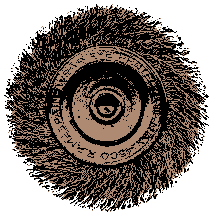
Machine! (Really!)
A big brother to the workhorse Vandercook SP-15 in the BAL pressroom, the 219 began its career in 1938 at Drent Engraving in Omaha, Nebraska. It would up in Lyons, Colorado, by way of a Denver printing equipment dealer, where a local artist used it as part of an ingenious method of printing his lithographs. But he needed the space and was willing to help the League move the massive machine. For diehard Book Arts League letterpress enthusiasts the offer of a scarce and unusual press so close at hand was too good to pass up. Finally, with the long-awaited move to the new studio in The Rocky Mountain Center for Musical Arts completed and the pressroom in operation, volunteers were free to turn their attention to a close examination and cleanup effort for the 219.
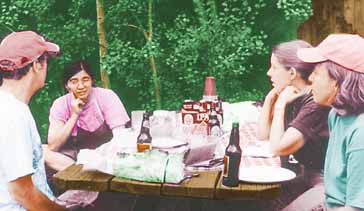
SO ON A FINE AUGUST AFTERNOON, the cleanup team met in Julie's backyard to fortify themselves before approaching the scene of the grime. There were spicy tamales and ribs, zesty cider and the traditional malt beverage printers have used for generations to ameliorate the effects of ink in the bloodstream. The crew armed themselves with rags and solvent, steel wool, emery cloth, and toothbrushes. A popular tool was the rotary wire brush mounted in an electric drill, a device which works by transferring grime from the item being cleaned to the face and clothing of the person operating the drill. Gradually, the surfaces of the press began to take on the dull glow of polished steel and bronze.
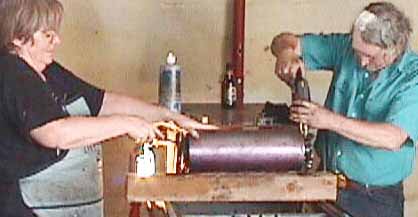 THE MASSIVE press was found to be in excellent condition, needing only minor repairs. A drive belt was replaced. Mysteries were explored: Why was an automotive lug wrench found suspended from the interior mechanism of the press? Answer: to provide just the right amount of tension to a balky drive chain. The feedboards were removed for varnishing. The climax of the afternoon came with the replacement of the massive cylinder which had been removed for transport. Several struggling printers managed to lift the awkward, heavy cylinder and crank assembly high enough to set it on the press bed. To operate properly, the gear teeth on the cylinder must engage the rack gears along the bed exactly, and the printers braced for further struggles. But when the crank was turned, the cylinder was found to be in exactly the right position, a cause of much wonderment and celebration.
THE MASSIVE press was found to be in excellent condition, needing only minor repairs. A drive belt was replaced. Mysteries were explored: Why was an automotive lug wrench found suspended from the interior mechanism of the press? Answer: to provide just the right amount of tension to a balky drive chain. The feedboards were removed for varnishing. The climax of the afternoon came with the replacement of the massive cylinder which had been removed for transport. Several struggling printers managed to lift the awkward, heavy cylinder and crank assembly high enough to set it on the press bed. To operate properly, the gear teeth on the cylinder must engage the rack gears along the bed exactly, and the printers braced for further struggles. But when the crank was turned, the cylinder was found to be in exactly the right position, a cause of much wonderment and celebration.
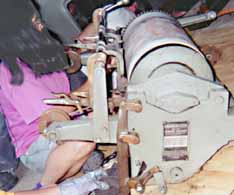
THE 219 NOW STANDS READY for action. A workshop using this press with its 18 x 24 printing area at its present location will have to wait until early next year, unless some volunteer steps forward to insulate Julie's barn against cold weather.
The afternoon also marked the debut of the Official Book Arts League Tent, a canopy which will be used for shelter when the League participates in outdoor community events and festivals.
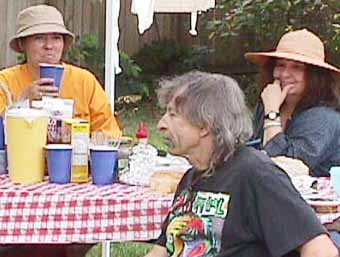
The Knights of the Picnic Table: L–R: Rob Slentz, Julie Seko, Barb Diehl, Nan Wigington [Linda Bevard, photo].
Linda Bevard (L) and Tom Parson polish the ink cylinder [Evert Brown, photo].
Julie works on the massive impression cylinder [Linda Bevard, photo].
Kay Moller (L) and Louise Padden keep a wary eye on a a very dirty old man. [Evert Brown, photo].